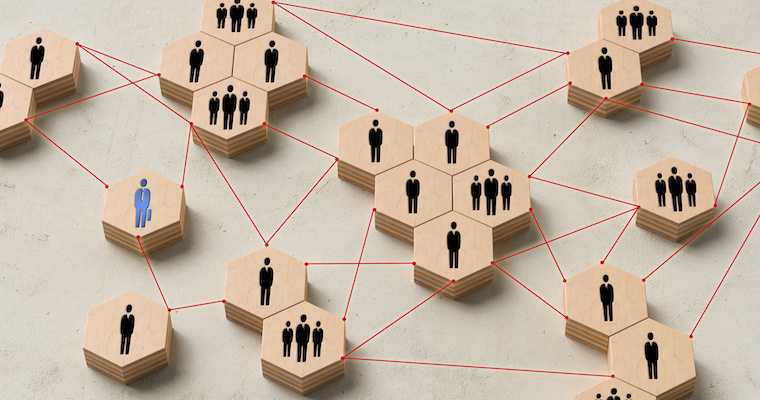From Solo to Team: Helping Siblings Maintain Your Valuable Outside Relationships

A family business founder or leader often toils for years to cultivate good relationships with people, organizations, and businesses outside the family, including banks, suppliers, customers, and the community where the business operates. These relationships are critical to the business’s success – for example, when the business needs capital for an expansion, quality raw materials, customer loyalty during a crisis, or a government permit for a new facility.
What happens to those great connections when the leader retires and a shared leadership team of siblings, cousins, or other younger relatives takes over the business?
Transferring these connections, which scholars call external ‘social capital,’ is a complex operation. However, our study of six Canadian firms that transferred their social capital reveals a strategy for doing it successfully.
Defining Social Capital
Social capital is the set of resources, information, favors and supports (current and potential) that can be obtained from an individual or organization’s network of relationships. It should be noted that individuals and organizations share interests and values with such networks of contacts and they interact together to attain common goals or purposes (adapted from Nahapiet & Ghoshal, 1998; Chetty et al., 2022).
External social capital is linked to the business’s external contacts -- customers, suppliers, subcontractors, financial institutions, government, consultants, advisers, civil associations, etc. These contacts represent intangible but critical capital for the company. Without them, the business will often struggle to operate. For instance, a business with such external social capital is well-placed to bring in better financing options for important projects, better variety (and better quality) of raw materials, better understanding of the evolving needs of customers and how to meet them, better knowledge about new technology trends, better knowledge of how to work with local governments, and richer collaboration with community members to address social problems. These contacts often evolve or change depending on the circumstances and the need to interact with one another.
So it’s easy to see that for the long-run survival of the firm between generations, external social capital must be preserved, strengthened and, above all, effectively transferred. This can be challenging because the external social capital is often built on a foundation of shared values and norms, mutual trust, and reciprocity built by the founder or leader. Transferring this social capital to several successors who are unfamiliar to the outside stakeholders can be especially challenging. Think of it this way: the business’s connections are really connections held by people. Passing on these critically important business relationships to successors and the next generation is difficult precisely because they are ultimately human relationships. While the family name will help create an initial bond for the newcomer, it is not inevitable by any means that critical business relationships held by the founder or leader will be inherited to the same level by the next generation or successor.
What We Studied
Our work involved an analysis of six cases of sibling succession, including interviews with 22 predecessors and successors of family firms located in Quebec, Canada, where nearly two-thirds of family firms have been transferred to shared leadership teams in recent years. Here are some of the questions we asked them:
- Who are their most important contacts, and what resources, information, favors and supports do we get (or could we get) from them?
- How is the relationship with these contacts (formal, informal, close, distant, etc.)? How was the relationship created?
- What do they do to retain and enrich that relationship? How did they identify the relationships they should keep or discard?
- How were the predecessor's contacts transferred to the successors?
- How was it decided which successor team member would acquire a certain contact and not another?
- How did the successor team members transfer their external social capital to each other?
What We Found
Formally or informally, all companies we studied compiled an inventory of their key contact network (e.g. most important customers, key suppliers, the key person for the business in the bank, etc.). These contacts are their external social capital. Here are some of the other key insights from our research
Two Types of Successors: Insider and Outsider
In companies taken over by a team of successors, we can find cases in which some of the predecessor’s children have worked at the company for a long time (insider successors) and others that were integrated just before or during the succession process (outsider successors). Along with the predecessor, the insider successors, who have worked in the business longer, also play a big role in transferring existing external social capital to the outsider successors, who join when the predecessor leaves.
Two Sources of Social Capital: Inter and Intragenerational
We saw two types of transfer of external social capital. In one, a sibling team of successors of a family business acquires the external social capital of the predecessor. We call this intergenerational transfer. One example is when the longtime leader transfers his or her close relationship with a strategic customer to the successor who takes over the sales and marketing department.
We also saw that the next generation leaders had their own external contacts, which they share with one another. We call this intragenerational transfer. For instance, one of the successors may have a close relationship with a former MBA classmate working at an accounting firm, and link up that person with a sibling who is taking over the family firm’s accounting and finance department. The accounting expert ultimately becomes a key advisor to the sibling.
Two Types of Roles: Operational and Strategic
In the companies we studied, prior to the succession the predecessor served as CEO and, as the succession process evolves, the siblings gradually became involved in operational functions (e.g., operations, finance, marketing, HR, etc.)Then the children held positions on the management team (e.g. finance director, marketing director, etc.) Team members with their own well-defined operational function were free to make their own decisions within their own domains; for example, the company's chief operating officer can freely decide to change the maintenance schedule of the machines.
During the succession process, in addition to the operational role of each team member acquired, the team also develops a strategic role. After that, the predecessor subsequently retired and the siblings took full control of the management team and thus the company. At this point, the sibling team runs the family business and owns it. As leaders and owners of the company, the children made strategic decisions together (e.g., acquisitions, launch a line of new products, decentralize a part of the production). Whether it is to make individual operational decisions or team strategic decisions, members of the sibling team mobilize their external social capital That leads to a dual transfer of external social capital.
Transferring Operational and Strategic Connections
We saw that predecessors transfer operational connections to each successor individually according to their operational roles. For example, the predecessor gradually transfers the relationship with the company that maintains the machines to the child responsible for operations.
However, strategic connections are transferred to the entire sibling team. When it concerns strategic issues, predecessors transfer important business relationships and contacts to the collective. For instance, through several meetings, the predecessor gradually conveys his key relationship with the head of the bank that finances them. The children on the succession team first establish contact and then present their strategic projects and funding needs. The team of siblings shares in this strategic external social capital.
Predecessors’ Connections and Successors’ Connections
Along with absorbing the predecessor’s social capital, successors also add new contacts from their own networks, which expands and renews the family’s external social capital. For example, a child who replaces the predecessor as a member of the Chamber of Commerce can obtain key information about new customers, new market trends, and new contacts with companies that could be future customers or suppliers. Another successor who once worked at a company with foreign subsidiaries might invite the CEO to join the family firm’s board if the firm wants to export to that country. Even outsider successors, who are newer to the business, have external social capital that can give the company new knowledge, resources, credibility, and innovation for expanding entrepreneurial opportunities. All of this will help when the family firm develops new projects.
The external social capital transferred by the predecessor and the external social capital added by the successors combine to form the family firm’s new generation of external social capital. Moreover, each successor (both insiders and outsiders) integrates his or her own personal or individual operational external social capital with the operational external social capital acquired from the predecessor, thus increasing the individual external social capital of those successors responsible for each management function. As a team or individually, successors review the inherited contacts and their own, and are free to prune away the ones that are not relevant to their new roles.
Takeaways
Finally, we identified the following best practices that we recommend to family businesses:
- Identify the main contacts and relationships of the predecessor that are part of the external social capital of the company and draw up an inventory.
- Classify these contacts as strategic or operational, specifying what each of them bring (or could bring) in terms of resources, information, favors and supports (current and potential).
- Make a plan to gradually transfer these relationships to the succession team. As successors acquire their operational functions, we recommend transferring the operational external social capital first.
- Subsequently, we recommend that the predecessor transfer the strategic contacts that are part of the external social capital of the company to all the successors once the succession process has been planned and is underway. Many experts recommend that the succession process take several years (depending on the size of the enterprise, the economic and social situation, and the degree of preparedness of the successors).
- Encourage insider successors who’ve worked at the business for a while to help transfer their own social capital to outsider successors who are new to the business. Encourage outsider successors to integrate their external social capital into the succession team.
- We recommend that successors evaluate whether to continue with predecessor relationships (or not) and to add their own relationships to the team.
Explore the Research
Successful family firm succession: Transferring external social capital to a shared-leadership team of siblings, Luis Cisneros, Bérangère Deschamps, Gabriel M. Chirita, Sebastien Geindre. Journal of Family Business Strategy, 2022.
[1] Gabiel Chirita is one of the autor of the source article. He passed away (October 2019) while the first version of the article for JFBS was being peer-reviewed.
EDITOR'S NOTE: This article was produced in partnership with the Journal of Family Business Strategy, a leading journal in the field of family business, as part of our mission to bring research-proven insights and practical advice to our readers.

Academic director of the Business families center and full professor / Dept. entrepreneurship & innovation / HEC Montreal
View Profile

Vice Dean University Grenoble Alpes - UGA / Grenoble IAE Graduate School of Management
View Profile





